Each species examined is grouped by family in phylogenctic sequence, as listed by Masuda ct al. (1980), and is arranged alphabetically within the family.
Family Synodontidae: Eso-ka
Saurida gracilis (Quoy ct Gaimard): Madara-eso
FUMT-P 4159, 4312.
Three specimens among the four collected in spring and summer had empty stomachs, whereas the other (109 mm SL) had fed on a small siganid fish.
Hiatt and Strasburg (1960) reported that this species in the Marshall Islands contained only small fishes in the stomach. Hobson (1974) similarly found an aulostomid fish in the single S. gracilis (165 mm SL) from Hawaii. Obviously these food data suggest that it is strictly piscivorous.
Hobson (1974, 1975) noted that synodontids are typical ambushers which rest immobile on the sea floor and suddenly attack prey which swim within striking distance.
Family Fistulariidae: Yagara-ha
Fistularia petimba Lacepede; Aoyagara
FUMT-P 4156; 3 specimens; summer; 137-360 mm SL.
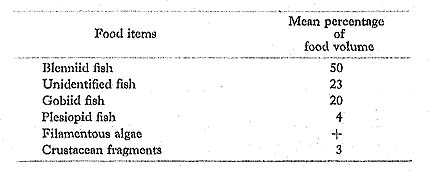
Benthonic small fishes constituted the major food of F. petimba at Minatogawa. Suyehiro (1942) reported that this species in Japan feeds on tiny floating organisms using its snout as a pipette. However, we found no evidence that it takes floating organisms, which agrees with the findings of Hiatt and Strasburg (1960) in the Marshall Islands and Hobson (1974) in Hawaii, where it preys exclusively on small fishes. The filamentous algae and crustacean fragments in the stomach probably were taken incidentally.
Hobson (1968, 1974, 1975) described F. petimba as a typical stalker which approaches prey slowly and suddenly attacks when it arrives within striking distance.
Family Syngnathidae: Yojiuo-ka
Corythoichthys haematopterus (Bleeker); Ishi-yoji
FUMT-P 4157, 4313; 9 specimens; spring and summer; 105-146 mm 8L.
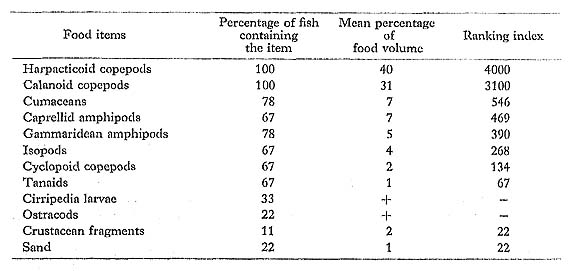
C. haematopterus had fed on small planktonic crustaceans, especially copepods. These prey are probably the "demersal zooplankters" described by Alldredge and King (1977), Hobson and Chess (1979), and Sano (1982). These organisms swarm in caves, crevices, and coral heads or hide in or on the substrata during the day, and at night they disperse above the reefs.
Hiatt and Strasburg (1960) recognized that two congeners, C'. flavofasciatus conspicillatus and C. intestinalis waitei, in the Marshall Islands feed on similar prey.
Family Sphyraenidae: Kamasu-ka
Sphyraena barracuda (Walbaum): Oni-kamasu
FUMT-P 4315.
Four specimens occurring above the upper outer reef slope in a small school were collected in spring. A single specimen had an empty stomach, whereas the other three (258-279 mm SL) had captured only small fishes.
Randall (1967) found that various fishes with very few octopuses and scyllarid lobster larvae compose the diet of S. barracuda from the West Indies.
Family Holocentridae: Ittodai-ka
Holocentrids are widely recognized as being nocturnal (Hiatt and Strasburg, 1960; Hobson, 1965, 1968, 1974; Collette and Talbot, 1972). During the day they remain under cover among overhanging rocks or in reef caves and crevices, and at night they emerge from their shelter and forage solitarily close to the reefs for feeding.
Flammeo sammara (Forsskål): Ukcguchi-ittodai
FUMT-P 4316; 4 specimens; spring; 71-131 mm SL.

The benthonic decapods that dominated in the diet of F, sammara at Minatogawa arc much the same prey as taken by the same species (reported as Holocentni.s sammara) in the Marshall Islands (Hiatt and Strasburg, 1960), Madagascar (Vivien and PeyrotClausade, 1974), and Hawaii (Hobaon, 1974).
Hobson (1974) described that species of the genera Sargocentron (as Adiorys), Flammeo, and Plectrypops feed primarily on benthonic decapods, especially xanthid crabs, whereas species of the genus Myripristis take mostly zooplankton, especially crab megalops, in the water column.
Family Mullidae: Himeji-ka
Mullids are well known as bottom-feeders which locate hidden prey from the sea floor with long sensory barbels on the chin (Randall, 1967; Hobson, 1975), Hobson (1974) noted that some mullids in Hawaii are mostly diurnal, others are primarily nocturnal, and still others hunt regularly during both day and night. All of the following mullida were mainly collected from exposed sandy areas adjacent to the coral or rocky reefs.
Mulloidichthys vanicolensis (Valenciennes): Aka-himeji
FUMT-P 4050.
Three specimens (103-109 mm SL) were collected in summer, but all had empty stomachs.
Parupeneus barberinus (Lacepède): Osuji-himeji
FUMT-P 4047, 4222; 11 specimens; spring and summer; 55-127 mm SL; 2 empty.
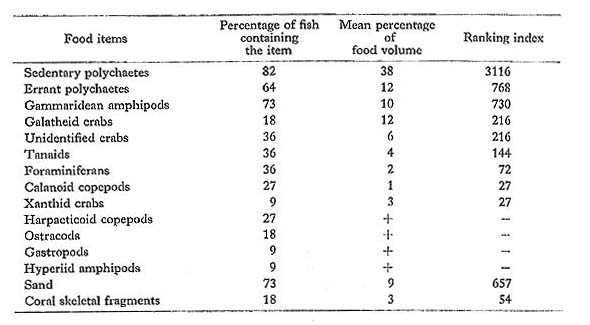
In eating mainly polychaetes and benthonic crustaceans, P. barberinus at Minatogawa had a diet similar to that of the same species in the Marshall Islands (Hiatt and Strasburg, 1960).
Parupeneus cyclostomus (Lacepède): Marukuchi-himeji
FUMT-P 4049.
The stomach of a single specimen (84 mm SL) collected in summer contained galatheid crabs (percentage of food volume: 45%), fishes (42%), shrimps (10%), and crab megalops (3%).
Hiatt and Strasburg (1960) reported that P. cyclostomus in the Marshall Islands is a carnivorous predator, feeding mostly on sand-dwelling crustaceans and benthonic small fishes.
Parupeneus pleurostigma (Bennett): Ryukyu-himeji
FUMT-P 4051.
A single specimen (69 mm SL) collected in summer had fed on galatheid crabs (percentage of food volume: 85%), shrimps (10%), harpacticoid copepods (+), and sand (5%).
Parupeneus spilurus (Bleeker): Okina-himeji
FUMT-P 4045, 4223; 28 specimens; spring and summer; 59-174 mm SL; 5 empty.

P. spilurus had taken various small animals, mostly crabs, demersal planktonic crustaceans, and small fishes. Guahima (1981) also reported that this species from Kuchicrabu Island, Japan, feeds chiefly on dccapods and other small crustaceans, including amphipods, isopods, mysids, and copepods.
Parupeneus trifasciatus (Lacepède); Ojisan
FUMT-P 4046, 4224; 25 specimens; spring and summer; 44-187 mm SL; 1 empty.

Small decapods and demersal planktonic crustaceans which predominated in the diet of P. trifasciatus at Minatogawa were also reported to be major prey of the same species in the Gilbert Islands (Randall, 1955), the Marshall Islands (Hiatt and Strasburg, 1960), and Kuchierabu Island (Gushima, 1981).
Upeneus tragula Richardson: Yome-himeji
FUMT-P 4048, 4225; 5 specimens; spring and summer; 56-188 mm SL.

Most of the prey of U. tragula were decapods.
Family Apogonidae: Tenjikudal-ka
Apogonids are widely recognized as being nocturnal (Randall, 1967; Collette and Talbot, 1972; Hobson, 1974; Vivien, 1975). During the day they secrete themselves in reef caves and crevices or in coral heads of branching corals, and at night they emerge above the reefs and feed on prey.
Suyehiro (1942) and Hiatt and Strasburg (1960) reported from Japan and the Marshall Islands, respectively, that females of several apogonids cease to take food when their ovaries are well developed. Similarly, Hobson (1965) observed that Apogon retrosella males in the Gulf of California cease to feed during the oral incubating period. Thus Hobson (1974) suggested that the relatively high incidence of empty stomachs of apogonids, as recognized also in the present study, is probably due to these phenomena.
Apogon aroubiensis Hombron et Jacquinot: Minami-futosuji-ishimochi
FUMT-P 4195, 4196; 4 specimens; spring and summer; 55-64 mm SL; 6 empty.

The many fish eggs in the stomach of A. aroubiensis at Minatogawa probably had been held in the mouths of these fish for incubation and accidentally swallowed when the fish were captured, as noted for other apogonids by Hiatt and Strasburg (1960) in the Marshall Islands and Hobson (1965) in the Gulf of California. We thus conclude that A. aroubiensis at Minatogawa preys on demersal zooplankters, especially small crustaceana.
Apogon cyanosoma Bleeker: Kinaen-ishimochi
FUMT-P 4093, 4188; 15 specimens; spring and summer; 26-48 mm SL; 17 empty.
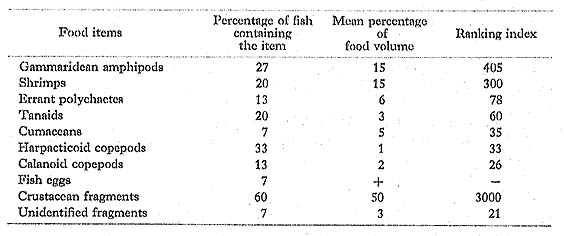
A. cyanosoma had eaten mostly demersal planktonic crustaceans. Vivien (1975) also
found zooplankters such as calanoid copepods and planktonic polychaetes and shrimps in the diet of this species (as Ostorhynchus cyanosoma) from Madagascar.
Apogon notatus (Houttuyn): Kurohoshi-ishimochi
FUMT-P 4094.
Of twelve specimens collected in summer, ten specimens were empty, whereas the other two (40 and 41 mm SL) had stomachs full of food, including errant polychaetes (mean percentage of food volume: 47%), copepods (25%), shrimps (3%), and crustacean fragments (25%). The errant polychaetes in the stomachs are probably the demersal zooplankters described by Alldrege and King (1977), which hide within sand substrata during the day and emerge to swim freely over the reef at night.
Apogon nubilus Garman: Hososuji-namida-tenjikudai
FUMT-P 4095, 4189; 22 specimens; spring and summer; 31-59 mm SL; 11 empty.

The many errant polychaetes taken as food by A. nubilus are probably demersal zooplankters, similar to those taken by A. notatus.
Apogon robustus (Smith et Radcliffe): Suji-ishimochi
FUMT-P 4096, 4190; 8 specimens; spring and summer; 45-74 mm SL; 3 empty.

A. robustus had taken small decapods and demersal planktonic crustaceans. The fish eggs found in the stomach probably had been held in the mouth for incubation and swallowed when captured, as noted in A. aroubiensis.
Apogon savayensis Günther: Namida-tenjikudai
FUMT-P 4097.
The major food item of the single specimen (40 mm SL) collected in summer was calanoid copepods (percentage of food volume: 95%), and the remaining items were harpacticoid copepods (5%) and decapod fragments (+).
Hobson and Chess (1978) found demersal planktonic crustaceans, especially crab megalops, mysids, and fish larvae, in the diet of the same species from Walt Island, Eniwetok Atoll, as did Vivien (1973; as Ostorhynchus savayensis) in Madagascar.
Cheilodipterus macrodon (Lacepède): Ryukyu-yarai-ishimochi
FUMT-P 4191.
A single large specimen (109 mm SL) captured in spring contained an unidentified small fish in the stomach.
Hiatt and Strasburg (1960) found only a blenniid fish, Istiblennius sp., in the single specimen (90 mm SL) that they examined in the Marshall Islands.
Cheilodipterus quinquelineatus Cuvier: Yarai-ishimochi
FUMT-P 4091, 4192; 10 specimens; spring and summer; 33-91 mm SL; 8 empty.

Small fishes and crustaceans constituted the major food of C. quinquelineatus at Minatogawa.
Fowleria aurita (Valenciennes): Shibori
FUMT-P 4092, 4193 ; 6 specimens; spring and summer; 30-56 mm SL; 2 empty.

F. aurita had eaten decapods and other small crustaceans, as did the same species from Madagascar examined by Vivien (1973).
Fowleria isostigma (Jordan et Scale): Nahamato-ishimochi
FUMT-P 4098, 4194.
A single specimen (62 mm SL) collected during the spring contained only small crabs in the stomach, whereas a single specimen (58 mm SL) collected during the summer had taken only small shrimps.
Family Serranidae: Hata-ka
Cromileptes altivelis (Valenciennes): Sarasa-hata
FUMT-P 4218.
A single specimen (91 mm SL) collected in spring contained only a small fish in the stomach.
Epinephelus caeruleopunctatus (Bloch): Hakuten-hata
FUMT-P 4037.
Only small fishes were taken as food by the single specimen (176 mm SL) collected in summer.
Epinephelus merra Bloch: Kanmon-hata
FUMT-P 4036, 4219; 16 specimens; spring and summer; 42-194 mm SL; 4 empty.

E. merra is the most common and widespread species among serranids on Minatogawa reefs. In feeding mostly on small fishes and deeapods, the diet of this species was essentially the same as that of the same species in the Marshall Islands (Hiatt and Strasburg, 1960), the Society Islands (Randall and Brock, 1960), and Madagascar (Vivien, 1973; Harmelin-Vivien and Bouchon, 1976).
Epinephelus moara (Temminck et Schlegel): Kue
FUMT-P 4220.
A single specimen (106 mm SL) collected in spring had an empty stomach.
Epinephelus summana (Forsskål): Nami-hata
FUMT-P 4221.
Of two specimens collected in spring, one was empty, while the other (74 mm SL) contained only small fishes.
Family Plesiopidae: Tanabatauo-ka
Plesiops coeruleolineatus Rüppell: Tanabatauo
FUMT-P 4044, 4182; 17 specimens; spring and summer; 33-57 mm SL; 1 empty.
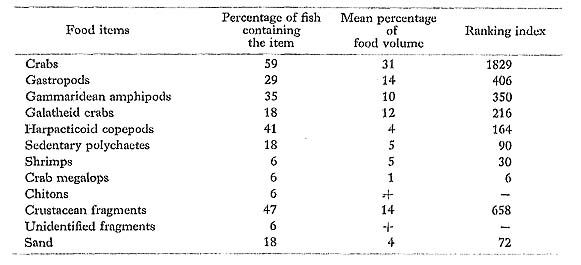
P. coeruleolineatus had taken mostly small crustaceans and gastropods.
Family Pseudochromidae: Megisu-ka
Like plesiopids, a characteristic feeding method of pseudochromids is to lie in ambush for prey to come near enough for capture and then lunge suddenly and rapidly (Hiatt and Strasburg, 1960; Sano, personal observation).
Labracinus cyclophthalmus (Müller et Troschel): Megisu
FUMT-P 4185; 4-specimens; spring; 52-60 mm SL; 2 empty.

L. cyclophthalmus had eaten chiefly small benthonic decapods and polychaetes.
Labracinus melanotaenia (Bleeker): Kurosuji-megisu
FUMT-P 4041, 4186; 9 specimens; spring and summer; 53-93 mm SL.
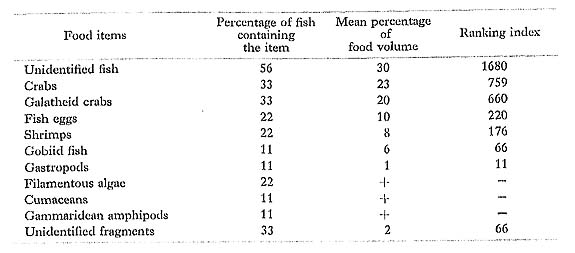
Most of the prey of L. melanotaenia were small fishes and benthonic decapods.
Labracinus spiloptera Bleeker: Okinawa-megisu
FUMT-P 4042, 4187; 7 specimens; spring and summer; 50-102 mm SL; 1 empty.
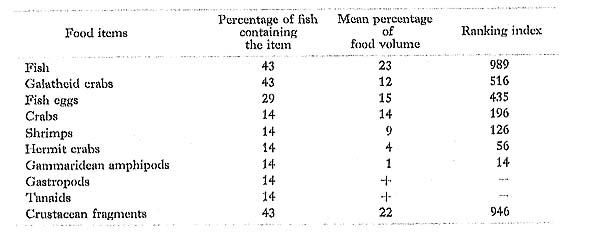
Like L. melanotaenia, this species had taken mostly small fishes, benthonic decapods, and fish eggs.
Pseudochromis melanotaenia (Bleeker); Kuroobi-nisesuzume
FUMT-P 4043, 4183; 5 specimens; spring and summer; 32-39 mm SL.
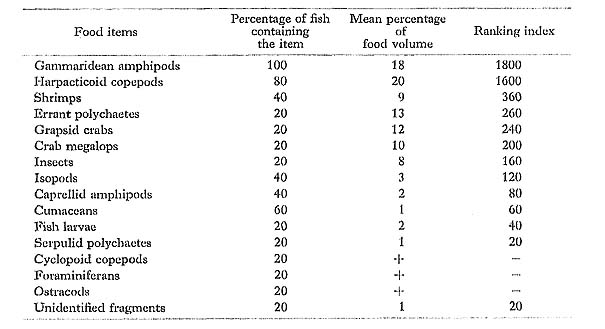
P. melanotaenia had captured a variety of demersal planktonic and benthonic animals, especially crustaceans, suggesting that it is a voracious carnivore.
Pseudochromis tapeinosoma Bleeker: Katsuiro-nisesuzume
FUMT-P 4184; 3 specimens; spring; 36-39 mm SL.

Like P. melanotaenia, this species had taken various demersal planktonic and benthonic animals, mostly crustaceans, which are much the same prey as taken by the same species in the Marshall Islands (Hiatt and Strasburg, 1960).
Family Gerreidae: Kurosagi-ka
Gerreids are widely recognized as predators on buried organisms, which they capture by plunging their highly protrusible mouths into the sediment and then ejecting the sand through the gill openings (Hiatt and Strasburg, 1960; Randall, 1967).
Gerres oyena (Forsskål): Kurosagi
FUMT-P 4160.
Two specimens (38 and 41 mm SL) collected from shallow sandy areas in summer contained errant polycliaetes (mean percentage of food volume: 50%), harpacticoid copepods (43%), calanoid copepods (+), and crustacean fragments (7%) in the stomachs.
Family Nemipteridae: Itoyoridai-ka
Scolopsis cancellatus (Cuvier): Yokoshima-tamagashira
FUMT-P 4161, 4317; 11 specimens; spring and summer; 46-99 mm SL; 2 empty.
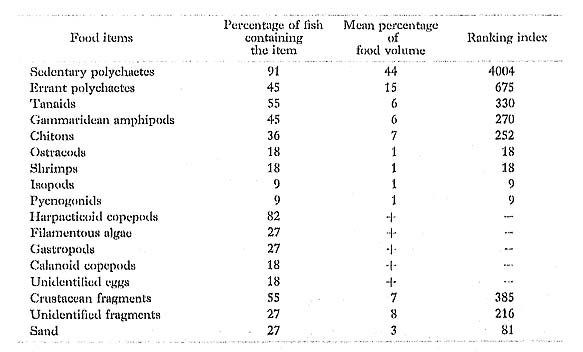
S. cancellatus had taken mostly polychaetes and demersal planktonic crustaceans. Hiatt and Strasburg (1960) found crab fragments and gurry in the two specimens (40 and 137 mm SL) that they examined in the Marshall Islands.
Family Lutjanidae: Fuedai-ka
Lutjanids are generally nocturnal carnivores (Hobson, 1965, 1968; Randall, 1967; Collette and Talbot, 1972), but several species of the genus Lutjanus also take prey during the day on occasion (Randall and Brock, 1960; Hobson, 1968).
Lutjanus fulviflamma (Forsskal): Nise-kurohoshi-fuedai
2FUMT-P 4162, 4318; 8 specimens; spring and summer; 42-120 mm SL.

All of the specimens were collected from among small groups of five to ten individuals occurring in shallow sandy areas. Most of the prey of this species were small fishes and decapods. According to our field observation, the young fish sometimes hunt prey during the day.
Lutjanus kasmira (Forsskål): Yosuji-fuedai
FUMT-P 4163.
A single specimen (85 mm SL) was collected from one of many small coral patclies scattered in shallow sandy areas in summer. Its major food item was gonodactylid stomatopods (percentage of food volume: 80%), and the remaining item was galatheid crabs.
Randall and Brock (1960) found that five specimens of L. kasmira in the Society Islands contained only fishes and another four had taken only crustaceans, mostly crabs and shrimps.
Lutjanus russelli (Bleeker): Kurohoshi-fuedai
FUMT-P 4164.
A single specimen (69 mm SL) collected from a shallow sandy area in summer contained only euphausids in the stomach.
Family Lethrinidae: Fuefukidai-ka
Gnathodentex aurolineatus (Lacepède): Nokogiridai
FUMT-P 4319; 11 specimens; spring; 102-128 mm SL.
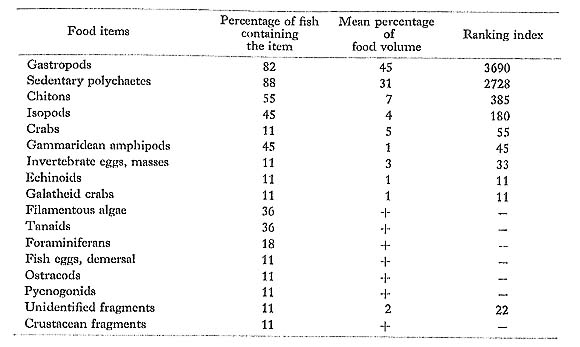
During the day G. aurolineatus was relatively inactive in loose aggregations of ten to twenty individuals close to the coral or rocky reefs at Minatogawa. These daytime aggregations suggest that it is probably a nocturnal predator, because similar aggregations arc frequently seen in lutjanids and certain other nocturnal fishes (Hobson, 1965, 1968; Collette and Talbot, 1972).
G. aurolineatus at Minatogawa had taken mainly small sessile invertebrates, especially haliotid and patellid gastropods and sedentary polychaetes. Clearly, these food data indicate that this species is a carnivore which mostly tears off sessile invertebrates from hard substrata. In the Marshall Islands, however, Hiatt and Strasburg (1960) reported that "it is apparently a solitary carnivore which takes both food at the surface or in mid-water (ailveraides) and benthonic fauna (xanthid crabs, polychaetea, and cerithid gas-tropoda)."
Lethrinus mahsena (Forsskål): Iso-fuefuki
FUMT-P 4165, 4320.
A single specimen collected from a shallow sandy area during the spring had an empty stomach, whereas another (69 mm SL) taken in the same habitat during the summer contained only decapods.
Walker (1978) found that the dietary items for 12 specimens (254-350 mm SL) of L. mahsena in the Great Barrier Reef were crabs, gastropods, sea urchins, fish, bivalves, sand dollars, starfish, and ophiuroids.
Lethrinus nematacanthus Bleeker: Ito-fuefuki
FUMT-P 4166; 5 specimens; summer; 56-73 mm SL.

All the specimens of L. nematacanthus examined were young, collected in a mixed group with Gerres oyena in shallow sandy areas. Most of their prey consisted of small fishes and decapods.
Lethrinus xanthochilus Klunzinger: Muneaka-kuchibi
FUMT-P 4167.
A single young specimen (72 mm SL), collected from a shallow sandy area in summer, contained only shrimps in the stomach.
Family Pomadasyidae: Isaki-ka
Plectorhynchus diagrammus (Linnaeus): Musuji-koshodai
FUMT-P 4168, 4321; 6 specimens; spring and summer; 60-80 mm SL; 1 empty.
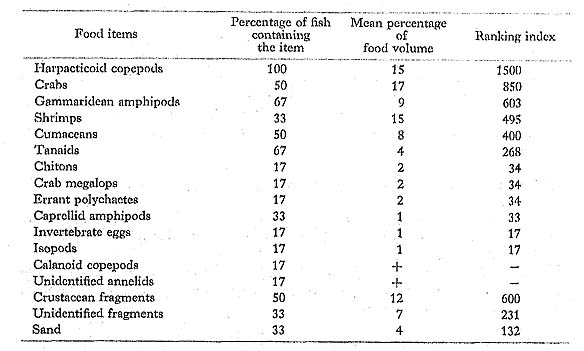
All the specimens of P. diagrammus examined were young, and their prey were mostly demersal planktonic crustaceans and small decapods.
Family Mugiloididae: Toragisu-ka
Parapercis cephalopunctata (Scale): Wanuke-toragisu
FUMT-P 4040, 4215.
This species is rare at Minatogawa, where it occurs on rocky surfaces in the outer reef flat.
A single specimen (117 mm SL) captured in spring contained only gonodactylid stomatopods in the stomach, whereas another (114 mm SL) collected in summer had taken xanthid crabs (percentage of food volume: 65%) and shrimps (35%).
Hiatt and Strasburg (1960) reported that this species in the Marshall Islands is a voracious, demersal carnivore which captures mostly decapods, stomatopods, and fishes.
Parapercis cylindrica (Bloch): Dandara-toragisu
FUMT-P 4038, 4216; 19 specimens; spring and summer; 48-89 mm SL; 1 empty.

P. cylindrica is the most common species of the congeners at Minatogawa, where it
occurs in exposed sandy areas adjacent to coral reefs, on flattened rocky reefs, or under coral heads. It had taken a variety of organisms, especially algae, small crustaceans, eggs, and polychaetes. Undoubtedly these food data suggest that it is strictly omnivorous.
Parapercis hexophtalma (Cuvier): Naname-toragisu
FUMT-P 4039, 4217; 11 specimens; spring and summer; 88-161 mm SL.
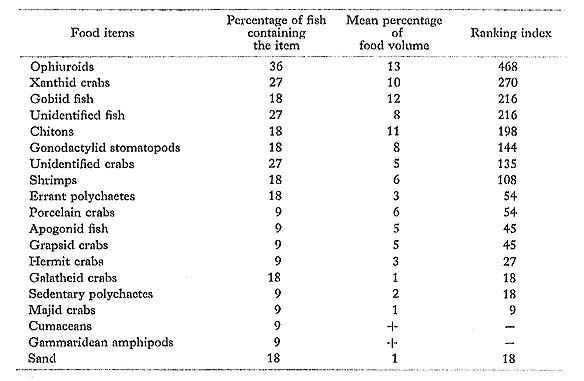
P. hexophtalma at Minatogawa occurs in exposed sandy areas adjacent to the coral reefs. In contrast to the omnivorous P. cylindrica, this species appears to be strictly carnivorous.
Family Callionymidae: Nezuppo-ka
Synchiropus ocellatus (Pallas): Kowanteguri
FUMT-P 4169, 4322; 8 specimens; spring and summer; 40-73 mm SL.
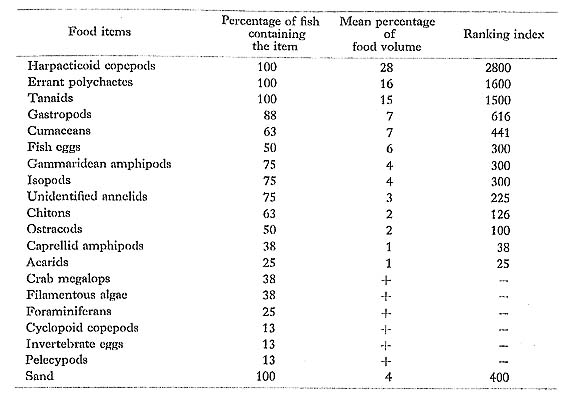
S. ocellatus usually lies in or near caves and crevices of rocky reefs or sometimes just beneath coral heads at Minatogawa. This species had taken mostly demersal planktomc crustaceans and polychaetes.



























